Charles E W Bean, Diaries, AWM38 3DRL 606/243A/1 - 1916 - 1934 - Part 19
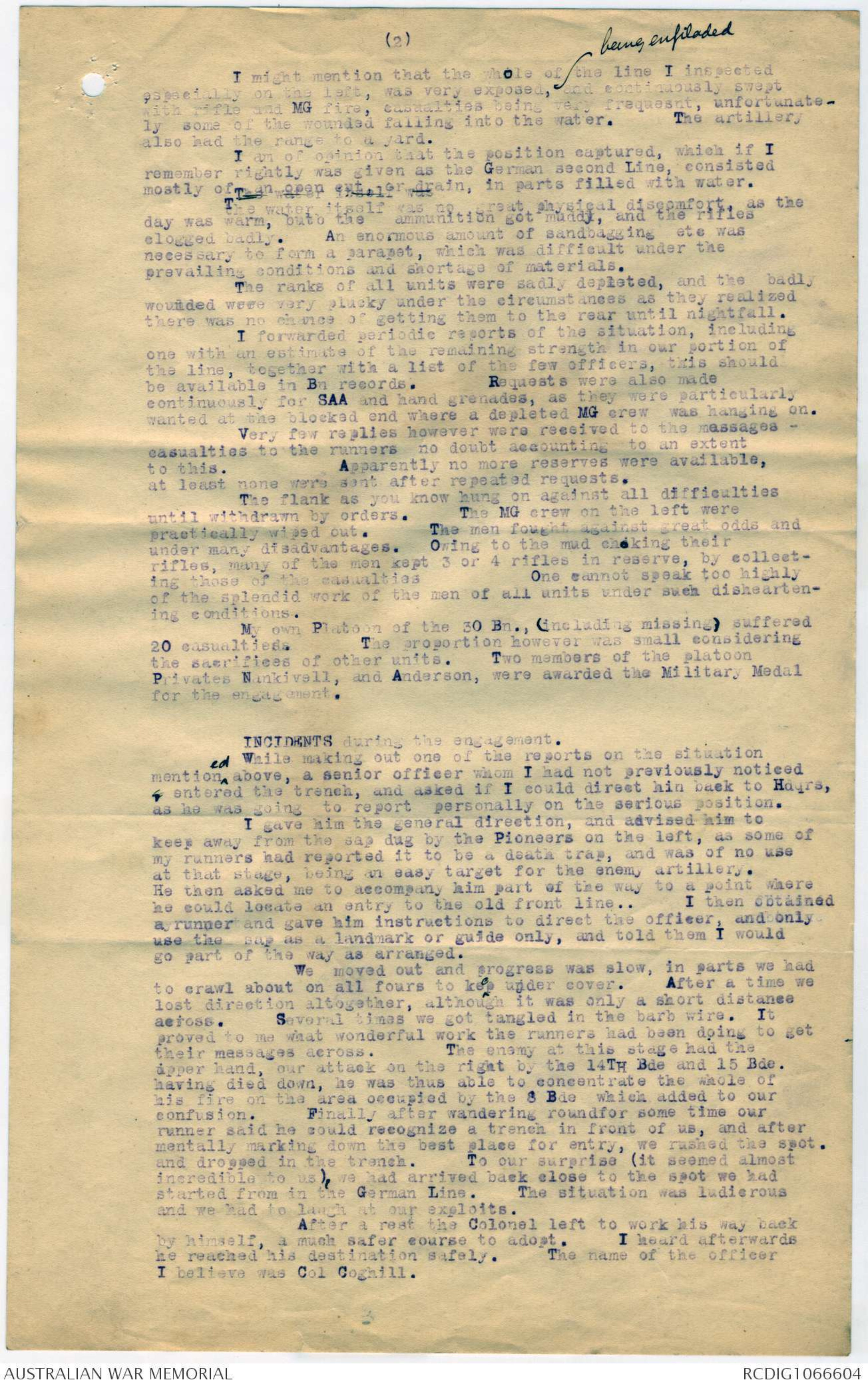
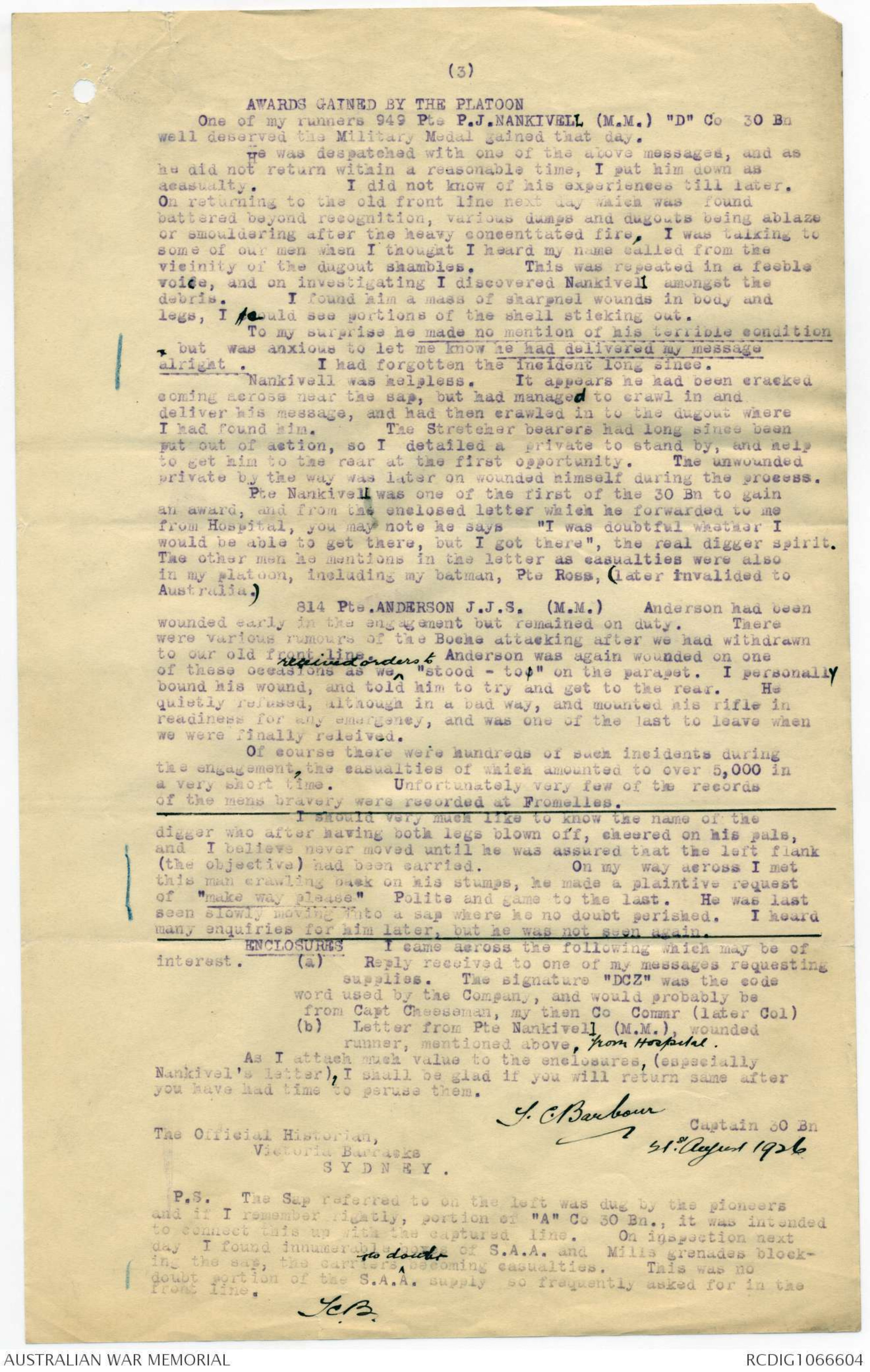
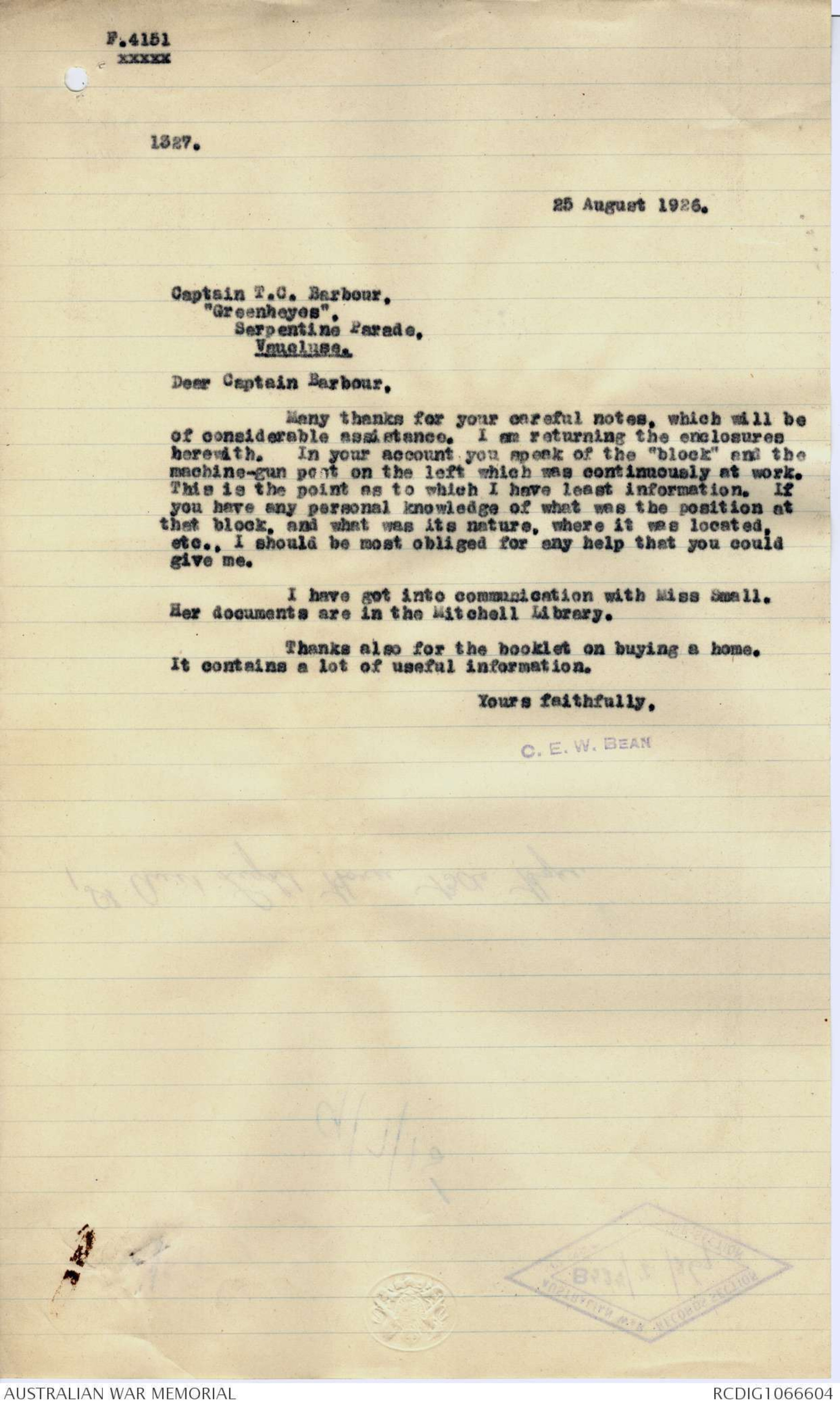
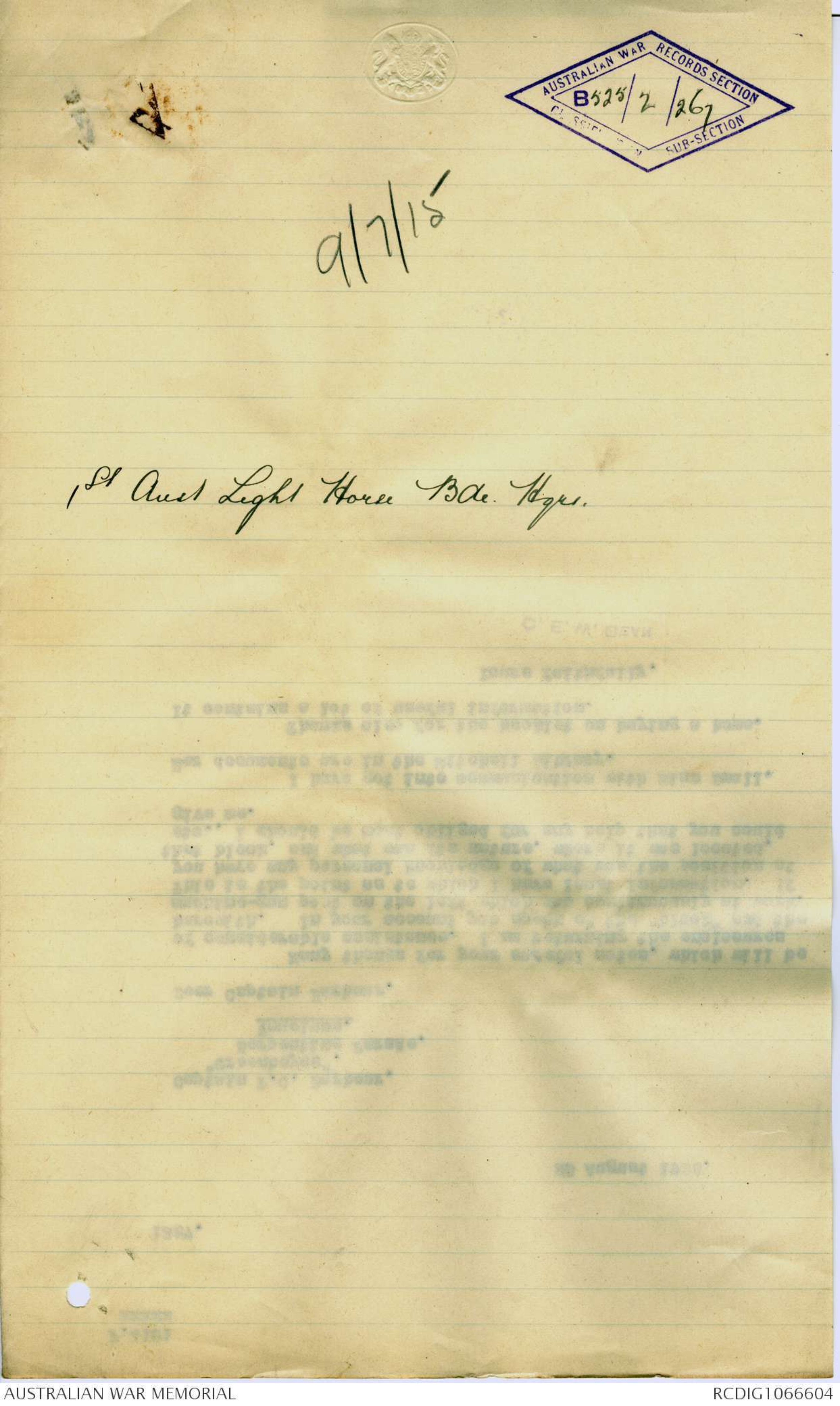
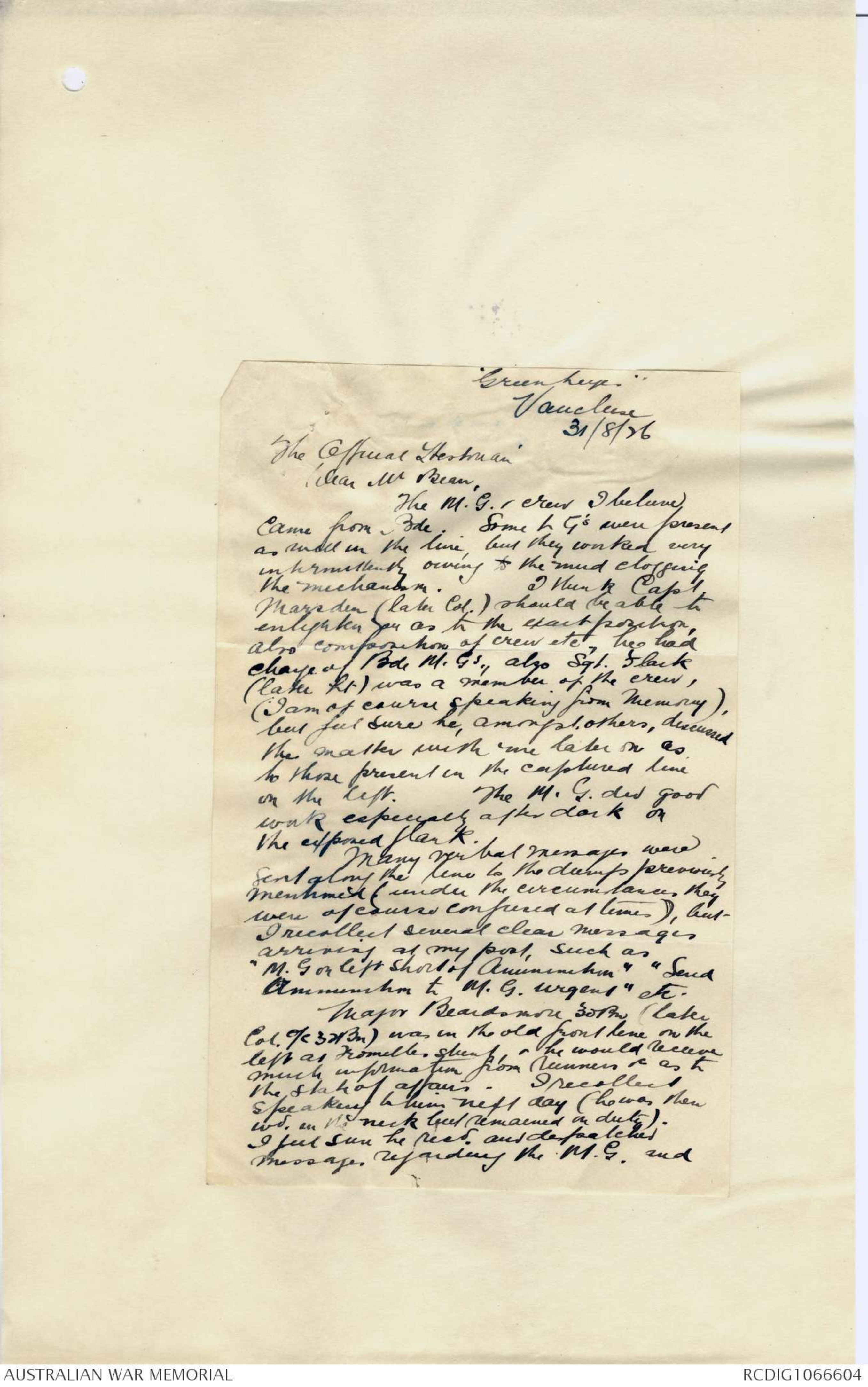
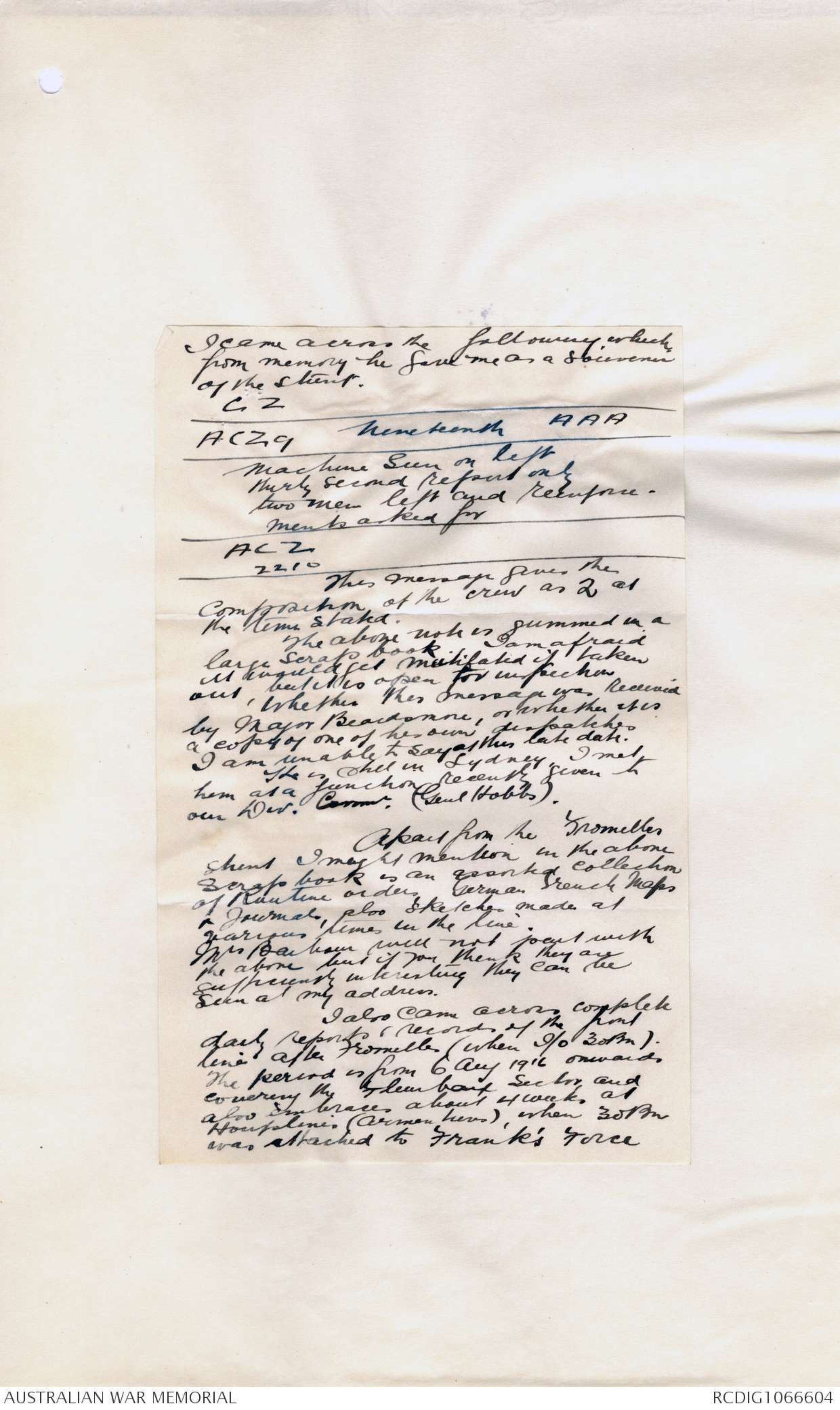
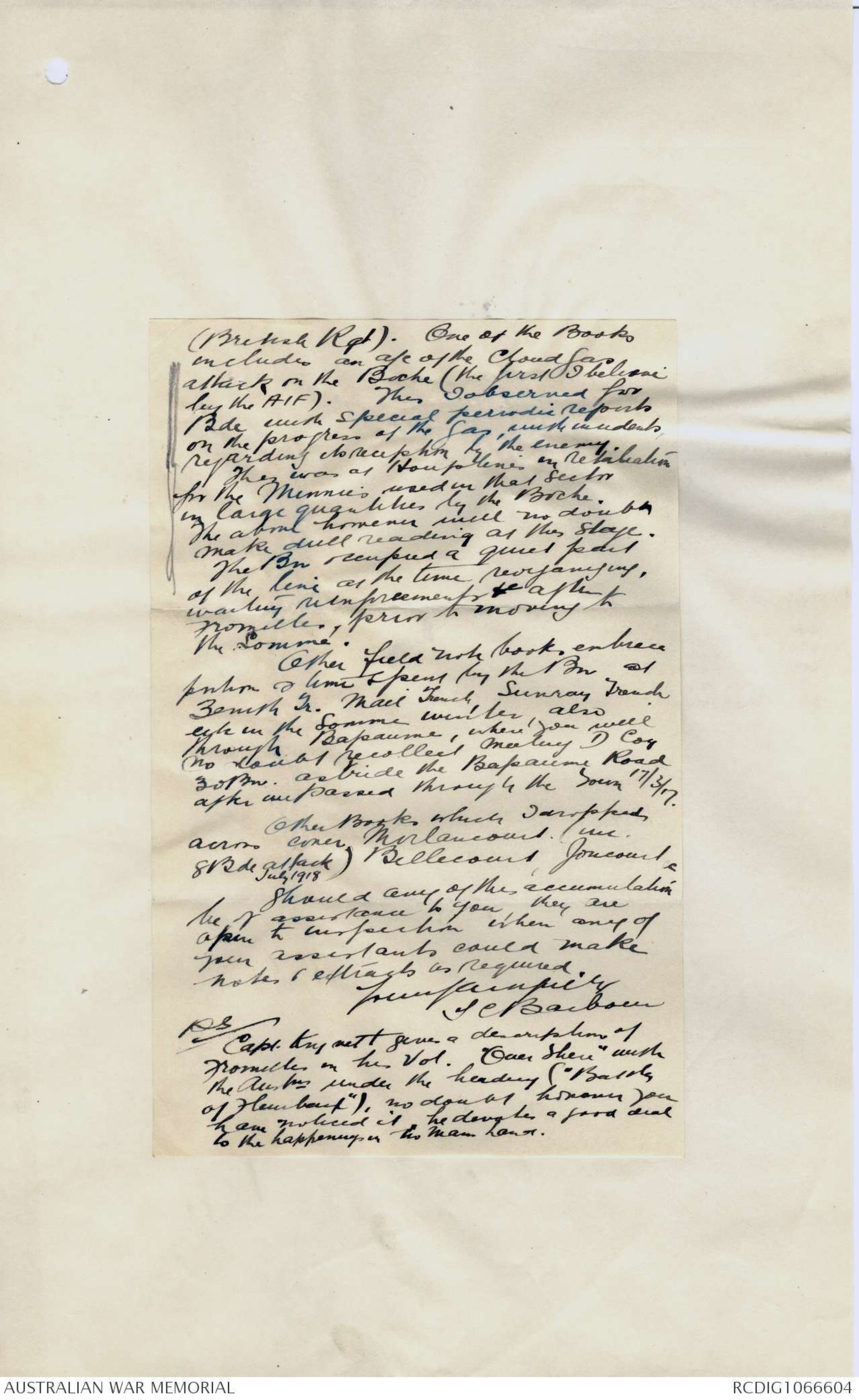
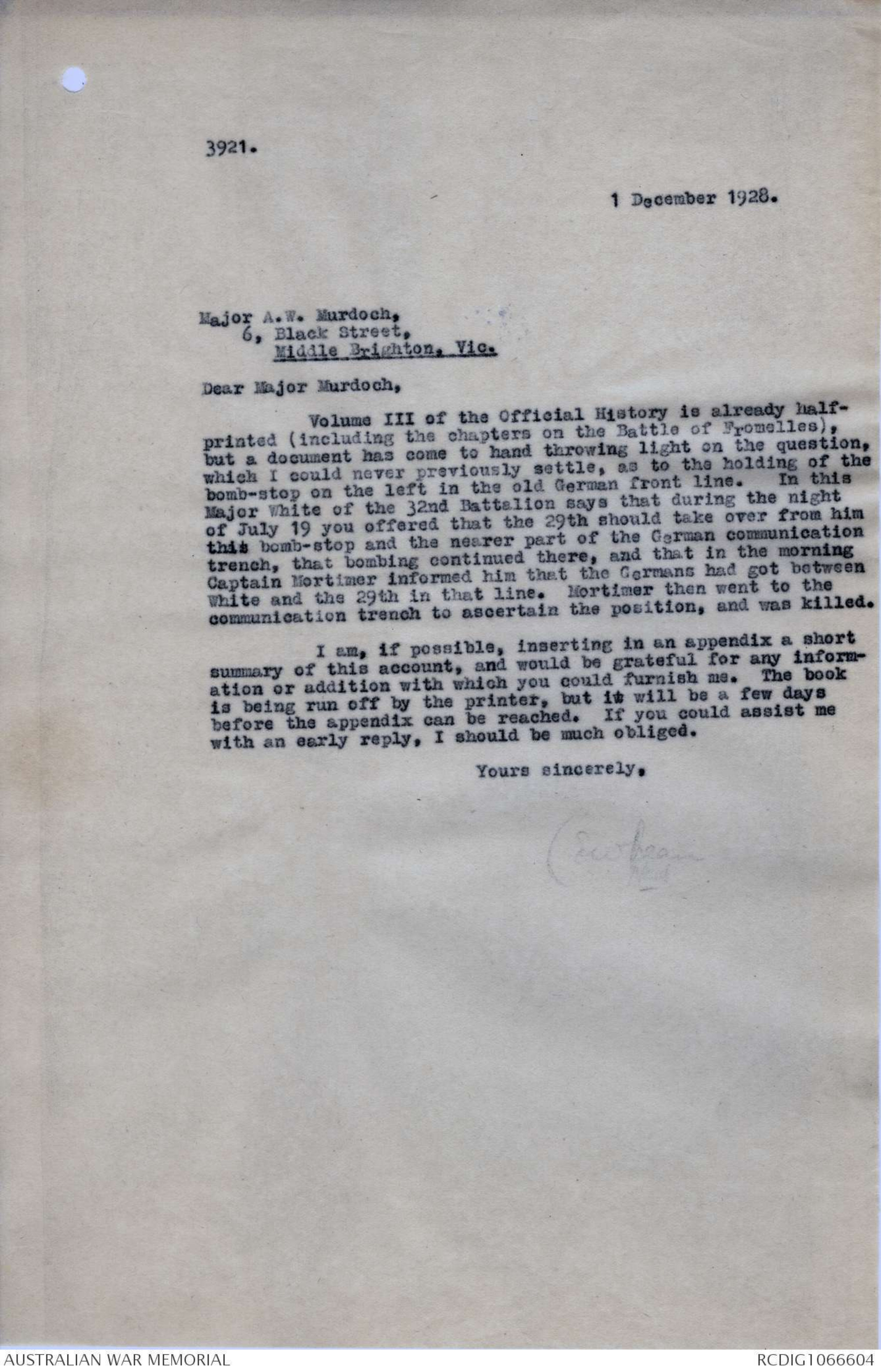
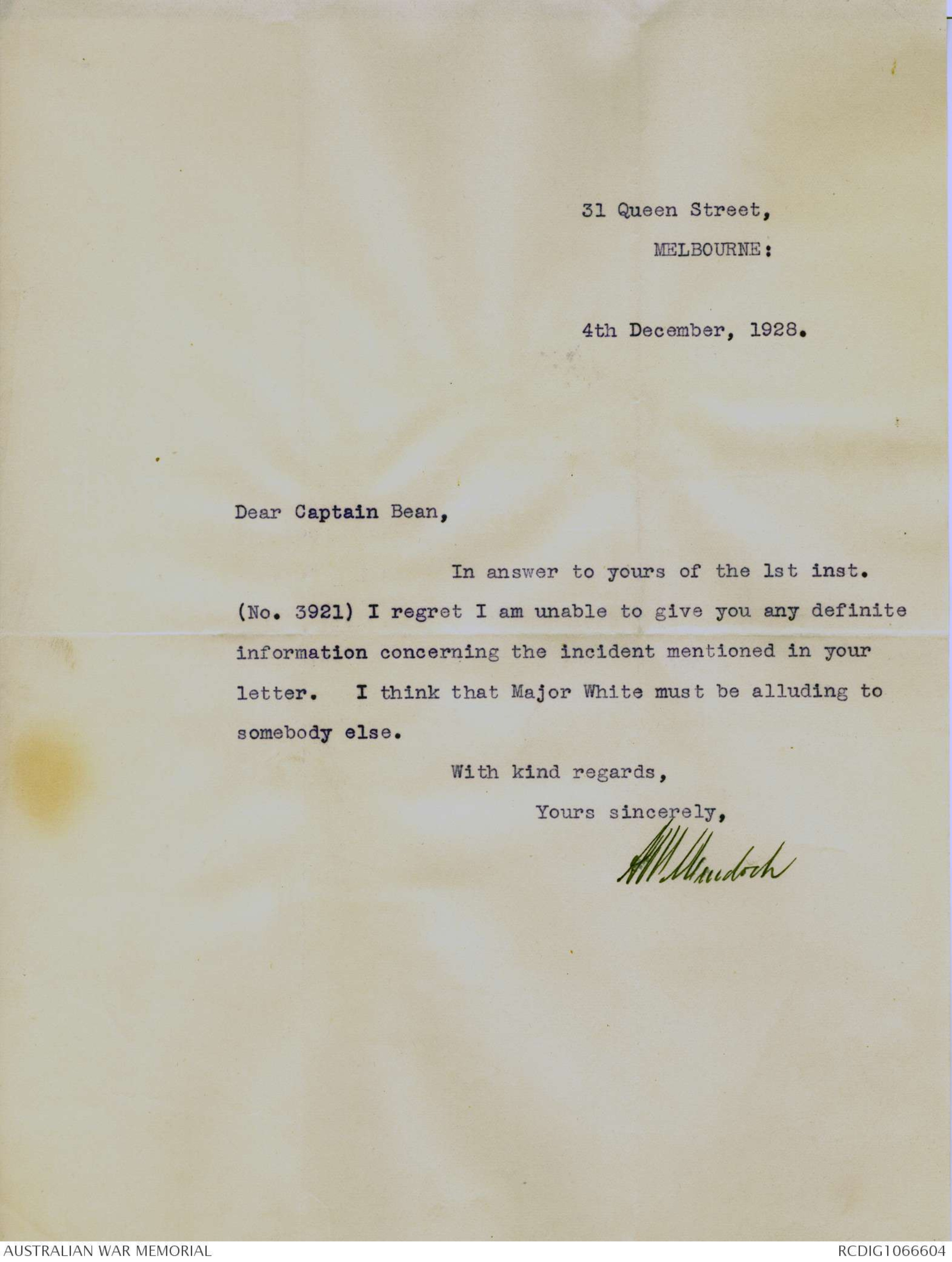
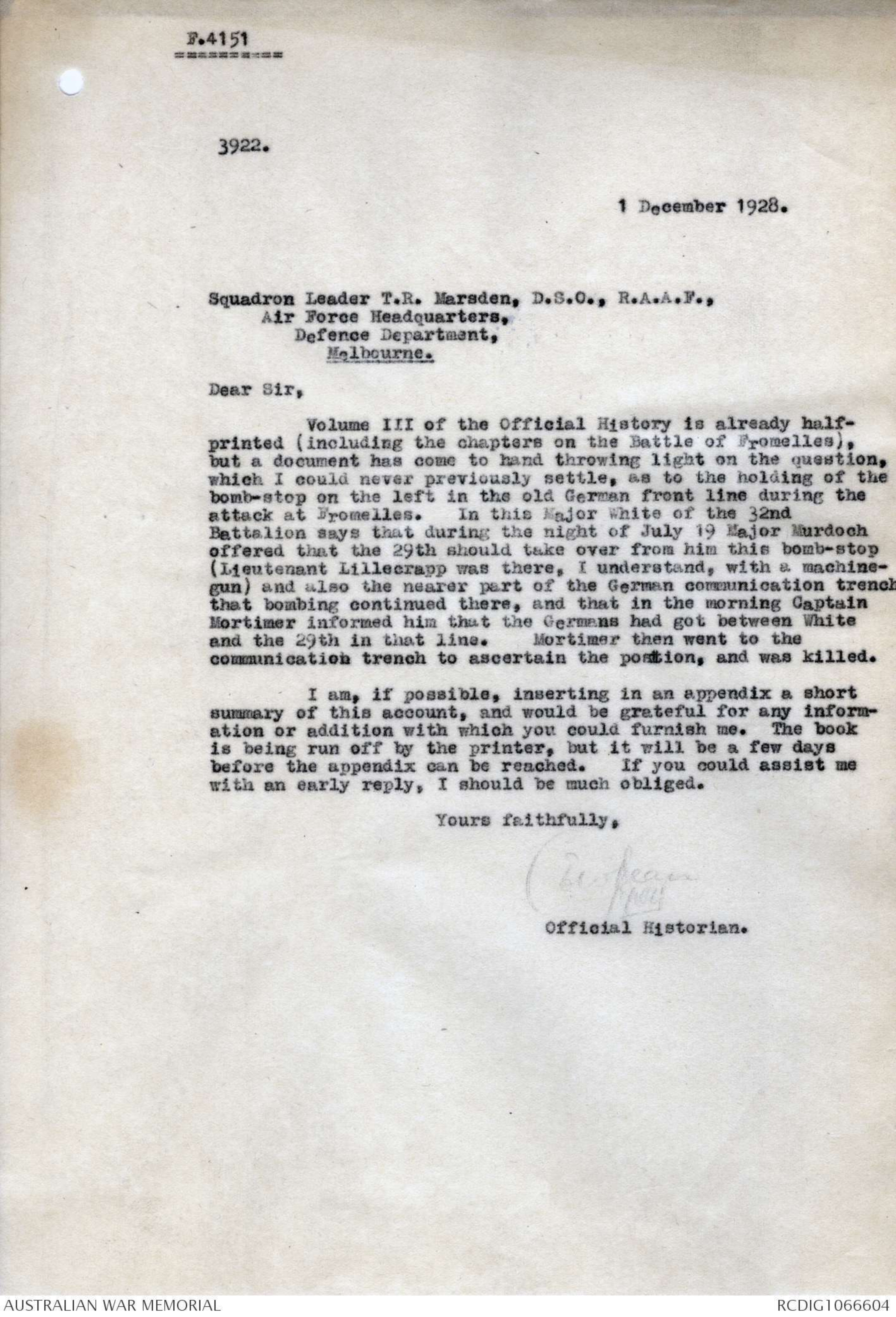
(2)
I might mention that the whole of the line I inspected
especially on the left, was very exposed, ^ being enfiladed and continuously swept
with rifle and MG fire, casualties being very frequent, unfortunately
some of the wounded falling into the water. The artillery
also had the range to a yard.
I am of opinion that the position captured, which if I
remember rightly was given as the German second Line, consisted
mostly of an open cut or drain, in parts filled with water.The water itself was
The water itself was no great physical discomfort, as the
day was warm, buto the ammunition got muddy, and the rifles
clogged badly. An enormous amount of sandbagging etc was
necessary to form a parapet, which was difficult under the
prevailing conditions and shortage of materials.
The ranks of all units were sadly depleted, and the badly
wounded were very plucky under the circumstances as they realized
there was no chance of getting them to the rear until nightfall.
I forwarded periodic reports of the situation, including
one with an estimate of the remaining strength in our portion of
the line, together with a list of the few officers, this should
be available in Bn records. Requests were also made
continuously for SAA and hand grenades, as they were particularly
wanted at the blocked end where a depleted MG crew was hanging on.
Very few replies however were received to the messages -
casualties to the runners no doubt accounting to an extent
to this. Apparently no more reserves were available,
at least none were sent after repeated requests.
The flank as you know hung on against all difficulties
until withdrawn by orders. The MG crew on the left were
practically wiped out. The men fought against great odds and
under many disadvantages. Owing to the mud choking their
rifles, many of the men kept 3 or 4 rifles in reserve, by collecting
those of the casualties. One cannot speak too highly
of the splendid work of the men of all units under such disheartening
conditions.
My own Platoon of the 30 Bn,.(including missing) suffered
20 casualties. The proportion however was small considering
the sacrifices of other units. Two members of the platoon
Privates Nankivell, and Anderson, were awarded the Military Medal
for the engagement.
INCIDENTS during the engagement.
While making out one of the reports on the situation
mention^ed above, a senior officer whom I had not previously noticed
entered the trench, and asked if I could direct him back to Hdqrs,
as he was going to report personally on the serious position.
I gave him the general direction, and advised him to
keep away from the sap dug by the Pioneers on the left, as some of
my runners had reported it to be a death trap, and was of no use
at that stage, being an easy target for the enemy artillery.
He then asked me to accompany him part of the way to a point where
he could locate an entry to the old front line.. I then obtained
a runner and gave him instructions to direct the officer, and only.
use the sap as a landmark or guide only, and told them I would
go part of the way as arranged.
We moved out and progress was slow, in parts we had
to crawl about on all fours to ke^ep under cover. After a time we
lost direction altogether, although it was only a short distance
across. Several times we got tangled in the barb wire. It
proved to me what wonderful work the runners had been doing to get
their messages across. The enemy at this stage had the
upper hand, our attack on the right by the 14th Bde and 15 Bde.
having died down, he was thus able to concentrate the whole of
his fire on the area occupied by the 8 Bde which added to our
confusion. Finally after wandering round for some time our
runner said he could recognize a trench in front of us, and after
mentally marking down the best place for entry, we rushed the spot.
and dropped in the trench. To our surprise (it seemed almost
incredible to us), we had arrived back close to the spot we had
started from in the German Line. The situation was ludicrous
and we had to laugh at our exploits.
After a rest the Colonel left to work his way back
by himself, a much safer course to adopt. I heard afterwards
he reached his destination safely. The name of the officer
I believe was Col Coghill.
(3)
AWARDS GAINED BY THE PLATOON
One of my runners 949 Pte P. J. NANKIVELL (M.M.) "D" Co 30 Bn
well deserved the Military Medal gained that day.
He was despatched with one of the above messages, and as
he did not return within a reasonable time, I put him down as
acasualty. I did not know of his experiences till later.
On returning to the old front line next day which was found
battered beyond recognition, various dumps and dugouts being ablaze
or smouldering after the heavy concenttrated fire. I was talking to
some of our men when I thought I heard my name called from the
vicinity of the dugout shambles. This was repeated in a feeble
voice, and on investigating I discovered Nankivell amongst the
debris. I found him a mass of shrapnel wounds in body and
legs, I could see portions of the shell sticking out.
To my surprise he made no mention of his terrible condition
but was anxious to let me know he had delivered my message
alright. I had forgotten the incident long since.
Nankivell was helpless. It appears he had been cracked
coming across near the sap, but had managed to crawl in and
deliver his message, and had then crawled in to the dugout where
I had found him. The Stretcher bearers had long since been
put out of action, so I detailed a private to stand by, and help
to get him to the rear at the first opportunity. The unwounded
private by the way was later on wounded himself during the process.
Pte Nankivell was one of the first of the 30 Bn to gain
an award, and from the enclosed letter which he forwarded to me
from Hospital, you may note he says "I was doubtful whether I
would be able to get there, but I got there", the real digger spirit.
The other men he mentions in the letter as casualties were also
in my platoon, including my batman, Pte Ross, (later invalided to
Australia.)
814 Pte. ANDERSON J. J. S. (M.M.) Anderson had been
wounded early in the engagement but remained on duty. There
were various rumours of the Boche attacking after we had withdrawn
to our old font line. Anderson was again wounded on one
of these occasions as we ^received orders to "stood - too" on the parapet. I personally
bound his wound, and told him to try and get to the rear. He
quietly refused, although in a bad way, and mounted his rifle in
readiness for any emergency, and was one of the last to leave when
we were finally releived.
Of course there were hundreds of such incidents during
the engagement, the casualties of which amounted to over 5,000 In
a very short time. Unfortunately vary few of the records
of the mens bravery were recorded at Fromelles.
l should very much like to know the name of the
digger who after having both legs blown off, cheered on his pals,
and I believe never moved until he was assured that the left flank
(the objective) had been carried. On my way across I met
this man crawling back on his stumps, he made a plaintive request
of "make way please" Polite and game to the last. He was last
seen slowly moving into a sap where he no doubt perished. I heard
many enguiries for him later, but he was not seen again.
ENCLOSURES
I came across the following which may be of
interest.
(a) Reply received to one of my messages requesting
supplies. The signature "DCZ" was the code
word used by the Company, and would probably be
from Capt Cheeseman, my then Co Commr (later Col)
(b) Letter from Pte Nankivell (M.M.) wounded
runner, mentioned above, from hospital
As I attach much value to the enclosures, (especially
Nankivel's letter), I shall be glad if you will return same after
you have had time to peruse them.
T C Barbour
Captain 30 Bn
31st August 1926
The Official Historian,
Victoria Barracks
SYDNEY.
P.S. The Sap referred to on the left was dug by the pioneers
and if I remember rightly, portion of "A" Co 30 Bn., it was intended
to connect this up with the captured line. On inspection next
day, I found innumerable boxes of S.A.A. and Mills grenades blocking
the sap, the carriers ^no doubt becoming casualties. This was no
doubt portion of the S.A.A. supply so frequently asked for in the
front line.
T.C.B.
F.4151
xxxxx
1327.
25 August 1926.
Captain T. C. Barbour,
"Greenhayes"
Serpentine Parade,
Vaucluse.
Dear Captain Barbour,
Many thanks for your careful notes, which will be
of considerable assistance. I am returning the enclosures
herewith. In your account you speak of the "block" and the
machine-gun post on the left which was continuously at work.
This is the point as to which I have least information. If
you have any personal knowledge of what was the position at
that block, and what was its nature, where it was located
etc., I should be most obliged for any help that you could
give me.
I have got into communication with Miss Small.
Her documents are in the Mitchell Library.
Thanks also for the booklet on buying a home.
It contains a lot of useful information.
Yours faithfully.
C. E. W. BEAN
AUSTRALIAN WAR RECORDS SECTION
B525/2/267
CLASSIFIED SUB-SECTION
9/7/15
1st Aus Light Horse Bde. Hqrs
"Greenhayes"
Vaucluse
31/8/26
The Official Historian
Dear Mr Bean,
The M.G. crew I believe
came from Bde. Some LG's were present
as well in the line, but they worked very
intermittently owing to the mud clogging
the mechanism. I think Capt
Marsden (later Col.) should be able to
enlighten you as to the exact position
also composition of crew etc, he had
charge of Bde M.G.s, also Sgt Flack
(later Lt) was a member of the crew,
(I am of course speaking from memory),
but feel sure he amongst others, discussed
the matter with me later on as
to those present in the captured line
on the left. The M.G. did good
work especially after dark on
the exposed flank.
Many verbal messages were
sent along the line to the dump previously
mentioned (under the circumstances, they
were of course confused at times), but
I recalled several clear messages
arriving at my post, such as
"M.G. on left short of ammunition" "Send
ammunition to M.G. urgent" etc.
Major Beardsmore 30 Bn (later
Co. o/c 32Bn) was in the old front line on the
left as Fromelles stunt & he would receive
much information from the runners &c as to
the state of affairs. I recollect
speaking to him next day (he was then
wd. in the neck but remained on duty).
I feel sure he recd. and despatched
messages regarding the M.G. and
I came across the following which
from memory he gave me as a souvenir
of the stunt.
G Z
ACZ9 Ninetenth AAA
Machine Gun on left
thereby Second reformd only
two men left and reinforcements
asked for
ACZ
2210
This message gives the
composition of the crew as 2 at
the time stated.
The above note is gummed in a
large scrap book. I am afraid
it could get mutilated if taken
out, but it is open for inspection
Whether this message was Received
by Major Beardsmore, or whether it is
a copy of one of his own despatches
I am unable to say at this late date.
He is still in Sydney, I met
him at a function recently given by
our Div. Commr. (General Hobbs).
Apart from the Fromelles
stunt I might mention in the above
scrap book is an assorted collection
of Routine orders German Trench maps
& journals, also sketches made at
various times in the line.
Mrs Barbour will not part with
the above but if you think they are
sufficiently interesting they can be
seen at my address.
I also came across complete
daily reports & records of the front
line after Fromelles (when I/O 30Bn).
The period is from 6 Aug 1916 onwards
covering the Fleubaix Sector and
also embraces about 4 weeks at
Houplines. (Armentieres), when 30Bn
was attached to Frank's Force.
(British Rgt). One of the Books
includes an a/c of the Cloud Gas
attack on the Boche (the first I believe
by the AIF). This observed for
Bde with special periodic reports
on the progress of the Gas, with incidents
regarding its reception? by the enemy.
This was at Houplines in retaliation
for the Minnies used in that sector
in large quantities by the Boche.
The above however will no doubt
make dull reading at this stage.
The Bn occupied a quiet part
of the line at the time reorganizing,
waiting reinforcements &c after
Fromelles, prior to moving to
the Somme.
Other field notebooks embrace
position & time spent by the Bn at
Zenith Tr. Mail Trench, Sunray Trench
life in the Somme winter, also
through Baupaume, where you will
no doubt recollect meeting D Coy
30Bn. Astride the Baupaume Road
after we passed through the town 17/3/17
Other Books which transported
across cover Morlancourt (use
8 Bde attack July 1918) Bellecourt, Joncourt
Should any of this accumulation
be of assistance to you they are
open to inspection when any of
your assistants could make
notes of extracts as required.
Yours sincerely
T C Barbour
PS
Capt. Knyvett gives a description of
Fromelles in his Vol. "Over There" with
the Austns under the heading (" Battle
of Fleubaix"), no doubt however you
have noticed it, he devotes a good deal
to the happenings in No Mans Land.
3921.
1 December 1928.
Major A. W. Murdoch,
6, Black Street,
Middle Brighton, Vic.
Dear Major Murdoch,
Volume III of the Official History is already half-printed
(including the chapters on the Battle of Fromelles),
but a document has come to hand throwing light on the question
which I could never previously settle, as to the holding of the
bomb-stop on the left in the old German front line. In this
Major White of the 32nd Battalion says that during the night
of July 19 you offered that the 29th should take over from him
this bomb-stop and the nearer part of the German communication
trench, that bombing continued there, and that in the morning
Captain Mortimer informed him that the Germans had got between
White and the 29th in that line. Mortimer then went to the
communication trench to ascertain the position, and was killed.
I am, if possible, inserting in an appendix a short
summary of this account, and would be grateful for any information
or addition with which you could furnish me. The book
is being run off by the printer, but it will be a few days
before the appendix can be reached. If you could assist me
with an early reply, I should be much obliged.
Yours sincerely,
CEW Bean
31 Queen Street,
MELBOURNE:
4th December, 1928.
Dear Captain Bean,
In answer to yours of the 1st inst.
(No. 3921) I regret I am unable to give you any definite
information concerning the incident mentioned in your
letter. I think that Major White must be alluding to
somebody else.
With kind regards,
Yours sincerely,
A W Murdoch
F. 4151
3922.
1 December 1928.
Squadron Leader T. R. Marsden, D.S.O., R.A.A.F.,
Air Force Headquarters,
Defence Department,
Melbourne.
Dear Sir,
Volume III of the Official History is already half-printed
(including the chapters on the Battle of Fromelles),
but a document has come to hand throwing light on the question,
which I could never previously settle, as to the holding of the
bomb-stop on the left in the old German front line during the
attack at Fromelles. In this Major White of the 32nd
Battalion says that during the night of July 19 Major Murdoch
offered that the 29th should take over from him this bomb-stop
(Lieutenant Lillecrapp was there, I understand, with a machine-gun)
and also the nearer part of the German communication trench
that bombing continued there, and that in the morning Captain
Mortimer informed him that the Germans had got between White
and the 29th in that line. Mortimer then went to the
communication trench to ascertain the position, and was killed.
I am, if possible, inserting in an appendix a short
summary of this account, and would be grateful for any information
or addition with which you could furnish me. The book
is being run off by the printer, but it will be a few days
before the appendix can be reached. If you could assist me
with an early reply, I should be much obliged.
Yours faithfully,
C E W Bean
Official Historian.
 Deb Parkinson
Deb ParkinsonThis transcription item is now locked to you for editing. To release the lock either Save your changes or Cancel.
This lock will be automatically released after 60 minutes of inactivity.